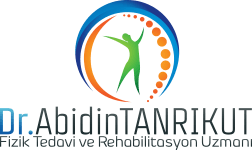High Voltage Galvanic Stimulation …
* 5. ULUSAL AĞRI KONGRESİ 3-6 EKİM 1999,İSTANBUL
HIGH VOLTAGE GALVANIC STIMULATION IN MYOFASCIAL PAIN SYNDROME
Abidin Tanrıkut, Nadire Özaras, Hüseyin Ali Kaptan, Zeynep Güven, Önder Kayhan
Marmara Unıversity School of Medicine Department of PM&R,
Istanbul, Turkey
Myofascial pain syndrome (MFPS) is characterized by painful trigger points in muscles and in association with this muscle spasm, tenderness, stiffness, joint motion restriction and referred pain.
Many different local modalities are tried for years in the treatment of this syndrome. Some of these are
transcutaneous electrical nerve stimulation, massage and acupuncture, High voltage galvanic stimulation
(HVGS) is a low frequency electrical current that has analgesic effects. The aim of this study is to show
the effectiveness of HVGS in treatment of the trigger point in myofascial pain syndrome.This placebo-
Controlled study is planned in the department of Physical Medicine and Rehabilitation, Marmara University
Hospital. We admited the patients with acute neck and back pain and who were diagnosed to have MFPS according to travel criteria. We iluded a total of 45 patients, of which 40 were women and 5 were men. Average age was 42. 1 and average duration of thr complaints was 7,6 months. Patients were randomly grouped as either “HVGS+exercise” or “placebo+exercise” or “only exercise control groups”. Therapy was applied for 10 sessions for 2 weeks.
HVGS was used in the frequency of 80-120 pps with the electrode on the trigger point for 20 minutes in the treatment group and stretch exercises for neck and back muscles were taught to patients. In the placebo group electrodes were applied but current passage was blocked by changing the channel. Stretch exercises were also taught to parients. Control group was followed by stretch exercises only. Paracetamol use was allowed for analgesic purposes in all patients but the amount
used per days recorded. Patients were evaluated before the sessions, after the sessions and 15 days after the treatment.
Pain measurement was done using the visual analog scale, trigger point tenderness index, anagesic use and patients general assessment. At the end of study pain, levels were decreased in patients of all three treatment groups, but the dercease was more significant in HVGS group.
(P> 0.05)Trigger point tenderness index was decreased significantly in treatment group.(P< 0.05) Patients in the placebo group had the same complaints. Therefore we conclude HVGS is effective in the treatment of tenderness in myofascial trigger points. Useful effects of HVGS continues in the mid term follow-up. HVGS can be accepted as a useful adjunctive modality in the treatment of trigger points.
